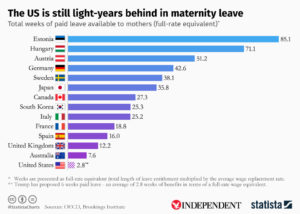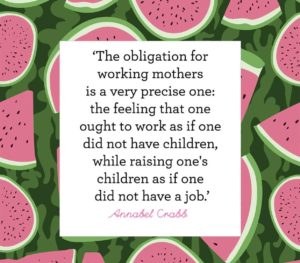
This is the unfortunate reality for many nursing mothers these days. I say ‘unfortunate’ because I can think of very few nursing mothers I have worked with over the years who really look forward to going back to work and leaving their babies. While I do believe that the optimal situation is for a baby to remain at home with his mother for the first several years of life, I know that this is just simply not an option for the majority of women today.
It’s hard enough to survive on two incomes without the added burden of supporting a new member of the family – and babies are expensive. Most mothers return to work or school simply because they feel they have to. Although many working mothers used to nurse for a few weeks and then wean before they go back to work, more and more moms are choosing to continue to nurse after they re-enter the work force. As the many advantages of breastfeeding become more obvious, mothers don’t want their babies to miss out on the benefits of nursing just because they have to return to work or school.
In 2017, seventy percent of mothers with children under 18 participate in the labor force, with over 75 percent employed full-time. Forty percent of U.S. households with children under 18 rely heavily on a mother’s income, and only 13 percent of workers in the U.S. have access to any paid leave. One in four US mothers return to work 10 days after giving birth. And just over one-third of American mothers don’t return to work after having a baby.
American moms are entitled to zero weeks of paid leave under federal law. Twenty-five years ago President Bill Clinton signed the Family and Medical Leave Act, which included a provision giving eligible workers 12 weeks of unpaid leave to care for a new child – emphasis on “unpaid.” The U.S. remains the only country in the developed world that does not mandate employers offer paid leave for new mothers. The world’s richest countries guarantee mothers more than a year of paid maternity leave. The U.S. guarantees them nothing.

It is never easy to be separated from your baby, and the lack of family friendly policies in the U.S. makes breastfeeding a challenge – but being able to nurse when you are together benefits both of you physically and emotionally. The look on your baby’s face when you walk in the door after a long separation as he eagerly anticipates ‘reconnecting’ at the breast makes the effort of maintaining the nursing relationship well worth it.
There are several articles which may be helpful in helping you continue to breastfeed after returning to work or school: Pumping and Storing Breast milk will give you detailed information about different types of pumps, how to maintain your milk supply, how much milk to leave for your baby, and how to store and handle expressed breast milk. Introducing Bottles and Pacifers to the Breastfed Baby will help you get your baby used to bottles before you return to work. Caregiver’s Guide to the Breastfed Baby will provide you with useful information for the person who will be caring for your baby while you are separated. It explains in detail the differences between formula-fed and breast-fed infant’s feeding, stooling, and sleeping patterns, as well as how to handle and store human milk as opposed to formula.
There are several important elements to consider in order to successfully continue nursing your baby when you return to work or school:
- Select an appropriate pump which will empty your breasts quickly and efficiently.
- Select a care provider who supports your commitment to breastfeeding.
- Arrange breaks at regular intervals (ideally, about every three hours) during your day in order to have time to pump.
- Find a private place to pump, preferably with access to an electric outlet.
- Establish a good milk supply after your baby is born and before you return to work or school. This will make maintaining your supply when you are separated much easier.
You will want to purchase or rent your pump no later than three weeks before returning to work. Even if you are at home with your baby for the first several weeks or months, it is helpful to have the pump to store up some milk to have on hand when you start working, to introduce baby to bottles so you can be sure he will take them when you leave him with a care provider, and to give you time to familiarize yourself with the operation and cleaning of your pump, as well as get an idea of how long each pumping session is likely to take.
Storing some milk beforehand in the freezer is a good idea, because even with a good pump, the stimulation you get while separated from your baby will be less than you are getting while you are together. Also, there is no pump on the market that is as efficient as the baby at removing milk and stimulating your supply. When you add in the fact that leaving your baby often creates stress, it isn’t surprising that many mother’s milk supplies will drop off somewhat when they return to work. You may have days that are more hectic than usual, or you just may not feel good physically some days. Your baby may go through a growth spurt, and demand may temporarily exceed supply. In the beginning, you won’t be sure exactly how much to leave for a feeding, although you will quickly find out how much he takes each day. Here are some suggestions on how to make the transition from stay at home breastfeeding mom to breastfeeding working mom:
- You’ll feel better if you have some extra milk stockpiled in the freezer. You don’t need to have gallons on hand, just enough for a few feedings. Pump after feedings for 5 minutes, or on the other side when your baby takes one breast at a feedings. Store the milk in 2-3 ounce portions. Expect your supply to be more plentiful in the mornings.
- Try to have at least 16 ounces on hand. If you have strong feelings about not wanting your baby to have any formula at all, or if he is allergic to formula, you may want to have a little more stored up.
- Selecting a care provider is seldom easy. Leaving your baby will be much less stressful if you feel really comfortable with your child care situation. Probably the ideal provider is a family member, like dad or grand mom. If this isn’t an option, you may want to look for a mother who provides child care in her home for 1 or 2 children, or a nanny who can come into your home. Putting a baby (especially a tiny infant) into a day care center with multiple infants is probably the least optimal situation, but if that is your only choice, talk to other parents whose children are enrolled. Look for a center with the highest possible ratio of adults to infants. Drop in unexpectedly and see how things operate when they aren’t expecting a visit. Be sure to let the care providers know that you are nursing. If they aren’t familiar with handling human milk or nurturing nursing babies, look elsewhere, or share the information in Caregiver’s Guide to the Breastfed Baby with them. Take comfort in the fact that breastfeeding protects your baby from many of the nasty germs that seem to get passed around day care centers.
- Try to do a ‘trial run’ the week before you return to work. Leave the baby with his caregiver and go to wherever you will be pumping. This will give you a chance to scope out the situation – Do you have an electric outlet? Do you need an extension cord? Do you need to find out which office space will be available, and when? Do you have access to hot water to clean your pump parts? Is there is refrigerator, and if so, can you store your milk in it if needed? etc, etc. You should also let the caregiver feed the baby while you’re gone, so you can see how he will take the bottle, and get an idea of how much he will take at a feeding. Leaving him for the first time is stressful enough, but will be easier if he is left in a familiar environment.
How often you pump when separated from your baby depends on several factors. One is whether your goal is to pump enough during the day for the baby to have exclusive breast milk feedings the next day, or whether you plan to combine formula and breastfeeding. You may decide to combine breast and formula feedings if your baby tolerates formula well and is used to it, or if your schedule at work doesn’t allow time for frequent emptying of your breasts. If your goal is for your baby to have only breast milk, then ideally you will empty your breasts about as often as he nurses when you are together. For example, if you return to work when your baby is is 6 weeks old and still nursing every 2-3 hours, then you should try to pump every 2-3 hours when you are separated. If you return to work when your baby is 6 months old, eating solid foods, and going 3-4 hours between feedings, you may only need to pump every 4 hours.
Here is an ‘optimal’ schedule for the mother of a young baby who wants to provide only breast milk for him while she’s at work:
- Set your alarm 20 minutes early (OUCH!). Nurse your baby, even if he is half asleep.
- Get both of you dressed and ready to go. Pack up everything you can the night before – diaper bag, bottles in cooler, lay out clothes, etc.
- Eat a good breakfast. Don’t skimp on this, even if it is something you can grab quickly like a carton of yogurt or bagel with cream cheese. Be sure to include a nutritious drink, like juice or milk. For a quick breakfast on the run, you can make smoothies by throwing just about any combination of milk, yogurt, and fruit in a blender. Smoothies are nutritious for you, and have the added benefit of tasting good. Just make sure you eat something. A protein shake will do in a pinch.
- Nurse again for a few minutes before you leave if possible. Some babies get so much milk at the first feeding that you can’t get them to eat again, but try anyway.
- Pump mid-morning. Allow at least 20-30 minutes for each pumping session (10-15 minutes for pumping with a good double pump, and 10 minutes for assembly and clean-up). Have a drink and a nutritious snack while you pump.
- Pump again at lunchtime. If possible, leave work and go to your day care site to nurse. More and more companies are providing on site day care, or you may live close enough to travel home and back if dad is watching the baby or your caregiver lives nearby. It may even be possible for your caregiver to bring your baby to you at lunchtime. Once again, eat a nutritious meal with something to drink.
- Pump again mid afternoon. Have a drink and a snack.
- Nurse as soon as possible after you pick your baby up from day care or return home.
- Eat a nutritious dinner.
Nurse your baby frequently during the night. Tucking him in bed with you is a good way to make up for the closeness and skin-to-skin contact that you miss out on during the day. Some babies start to nurse more frequently during the night when they are separated from their mothers during the day. This is called ‘reverse cycle feeding’ and works well for many mothers, especially if they find it hard to pump during the day. If baby is in bed with you, you will get the rest you need while he gets the milk and nurturing he needs.
Having given you the hypothetical ‘optimal’ schedule for a working mom, let me hasten to say that this is an ideal which most mothers find impossible to implement. No one said this would be easy. Just do the best you can.
- Don’t get the idea that if you can’t pump 3 times during the day, you shouldn’t even try to continue nursing. Many mothers have work schedules that are very inflexible, and they don’t have either the time or the place to pump more than once a day, or even not at all. If this is the case, you can still breastfeed. If at all possible, try to pump at least once during the day (usually you can find time at lunch, even if you don’t have any other breaks). Pumping even once a day will give you some stimulation, help maintain your supply, and help keep you from becoming engorged. If you are only able to pump once each day, you will probably have to supplement with formula, but at least your baby will have one feeding of breast milk, and you can continue nursing while you are together.
- I often have mothers ask me what will happen if they don’t pump at all during the day, but want to nurse in the mornings, evenings, and weekends when they are with their baby. The answer depends on the baby’s individual temperament, as well as his age. A young baby whose diet consists solely of milk is likely to lose interest in nursing when your supply drops drastically, as it is certain to do if you go an 8 or 9 hour stretch without emptying your breasts. This is not true for all babies, however, so it is worth trying if you absolutely can’t pump at work. The worse thing that will happen is that your supply will drop and your baby will wean himself. Some babies seem to enjoy nursing for the sake of nursing as much as for the milk, and will continue nursing no matter how low your supply gets. This is more likely to be the case with older babies who are nursing less frequently and eating solid foods. If you can’t pump at work, expect a period of engorgement, leaking, and discomfort while your body adjusts.
- Before returning to work, you may want to discuss your options with your employer. If at all possible, try to return on a part-time basis, even if only for a week or so. You may also try to return to work on a Friday rather than a Monday so that you’ll have the weekend to recover from your first day back.
- Another reason to have a discussion with your boss is to make him or her aware of any changes you may need to make in your work schedule. For example, you may need to take two 30 minute breaks instead of one 60 minute one.
- Find that you’re one of those employees covered by the new Affordable Care Act. (see details below). While all employers should be supportive of your efforts to continue nursing, you may occasionally encounter a boss or supervisor who not only is not supportive, but may actually be hostile when you try to pump at work. In situations like this, sending a copy of the following letter may be helpful:
To whom it may concern:
Jane Doe, the mother of a six week old breastfed infant, will be returning to work on a full time basis on March 11, 2015.
While nursing an infant this age, it is important for the mother to empty her breasts at regular intervals, ideally every two to three hours, in order to maintain her milk supply and prevent medical complications such as plugged ducts and mastitis (breast infection).
My recommendation is that Jane be allowed two fifteen minute breaks each day, in addition to her regular lunch break, in order to express her milk with an electric breast pump.
I hope that you will be willing to work with her regarding this matter, since regular milk expression during prolonged periods of mother-baby separation is in the best interest of both mother and child.
Please feel free to contact me with any questions that you might have.
Sincerely,
Anne Smith, IBCLC (International Board Certified Lactation Consultant)
Leaking at work is much more of a concern than leaking at home. (See Breast milk Leakage ) Some mothers experience minimal leaking, while others wake up with the sheets soaked every morning. While leaking does tend to lessen after the early weeks of nursing, many mothers still experience a significant amount of leakage when they are ready to return to work. Soaking through your shirt may be inconvenient while you are at the grocery store or visiting a friend, but when you are making an important presentation in front of your boss and a roomful of clients, it can be disastrous.
Here are some tips for dealing with leaking:
- If you feel your milk letting down, cross your arms across your chest and apply pressure for about ten seconds or so. No one but another nursing mother will know what you are really doing.
- Choose bright or dark colored prints. Avoid white and pastel colors. They show leaks more. Cotton and synthetic fabrics show leaks less than silks, linens, and clingy fabric
- Wear a loose jacket or blazer to throw over your blouse
- Wear clothes that are loose and comfortable. You may find that your pre-pregnant clothes don’t fit well anymore, so invest in a few multipurpose outfits that fit loosely. Choose outfits that button in the front or two piece outfits that you can pull up easily.
- Keep an extra shirt at work, one in a neutral color that can be worn with most outfits.This may seem obvious, but choose clothes that are washable and don’t wrinkle. Your life is complicated enough right now without adding ironing or even tumble pressing to your list of things to do.
It’s a well known fact that breastfed babies are healthier than those who are formula fed. They make fewer trips to the doctor, resulting in fewer health care claims and less time missed from work to care for a sick baby. Studies have also shown that when employers promote and encourage breastfeeding, it creates a better work environment and more loyal, satisfied employees. In 2010, new laws were passed to protect and encourage breastfeeding in the workplace. Under the Affordable Care Act, FLSA non-exempt employees are entitled to a private, clean place to pump, (not a bathroom), and ‘reasonable’ (although unpaid) break time, until your baby is 12 months of age. ‘Reasonable’ time has not been established. The ACA has mandated the minimum coverage nation-wide; but laws vary state by state. You may find that your state laws provide better employment protection than the state laws. All companies are expected to comply, but if they have less than 50 employees, or can prove that complying with the law would cause them ‘undue hardship’, they can apply for an exemption. If you’re not sure about your employee status, check your paycheck stub.
I know of several situations where employers didn’t want mothers to store their expressed milk in the refrigerator at work because they were concerned about “contamination”, since they argued that human milk is a body fluid and should be covered by the same precautions used with blood and saliva. Be assured that the policy of OSHA, the CDC, and the American Public Health Association is that human milk is not considered in the same category with other bodily fluids, and no special precautions are necessary, other than the standard hand washing and refrigeration protocols.
Continuing to breastfeed after returning to work is a real labor of love, but it is well worth the effort. No, it isn’t easy, and requires a great deal of commitment and work on your part. Only you can provide the best possible nourishment for your baby, and there is no doubt about the physiological benefits (immunities, fewer illnesses, less time missed from work), the financial benefits (cost savings associated with fewer doctor visits and not buying formula, which can cost over $200.00 each month, depending on the type), and the psychological benefits (the closeness, bonding, and skin-to-skin nurturing) that only you can provide.
It’s important to know what your legal rights are as a nursing mother. The Best for Babes website has all the information you need to understand what you are entitled to under the law: http://www.bestforbabes.org/top-5-tips-for-working-and-breastfeeding.
Here are some other resources you might find helpful:
- Under the Affordable Care Act, Insurance companies will be mandated to cover breast pumps and lactation support. (Effective August 1, 2012.)
- Lactation and the Law: An overview on the laws around breastfeeding in public and at
work, by one of the leading experts in the field, Jake Aryeh Marcus, JD. - State Laws on Breastfeeding: a comprehensive list describing the laws are in each state; if your state law provides better protection than the national minimum, it prevails.
- US Dept of Labor Bureau of Labor Statistics (April, 2018)
- The Shocking Number of New Moms Who Return to Work Two Weeks After Childbirth, Danielle Paquette, Washington Post, August 2015
- The ‘Fifth Trimester’: When New Moms Return to Work: Kelly Wallace, CNN, April 2017
- Frequently Asked Questions on Break Time for Nursing Mothers: developed by the United States Breastfeeding Committee, this excellent resource answers most common questions and is good link for you and your employer.
Important update as of 9/16/2011: If you are serving in the military or as a police officer, firefighter, or any other non-traditional type jobs, you have another set of rules to comply with. As of yet, he new health care act does NOT include the military. They have their own set of policies and regulations. Finding a time and place requires a lot more ingenuity when you are on the range, in the back of aircraft for 8 hours, or deployed overseas. While many of the suggestions above will work to some degree, there are unique challenges to face when pumping while in the military service. For more info and specific military policies, check out www.breastfeedingincombatboots.com
(Edited July, 2018)
Anne Smith, IBCLC
Breastfeeding Basics

 Breastfeeding Basics
Breastfeeding Basics




